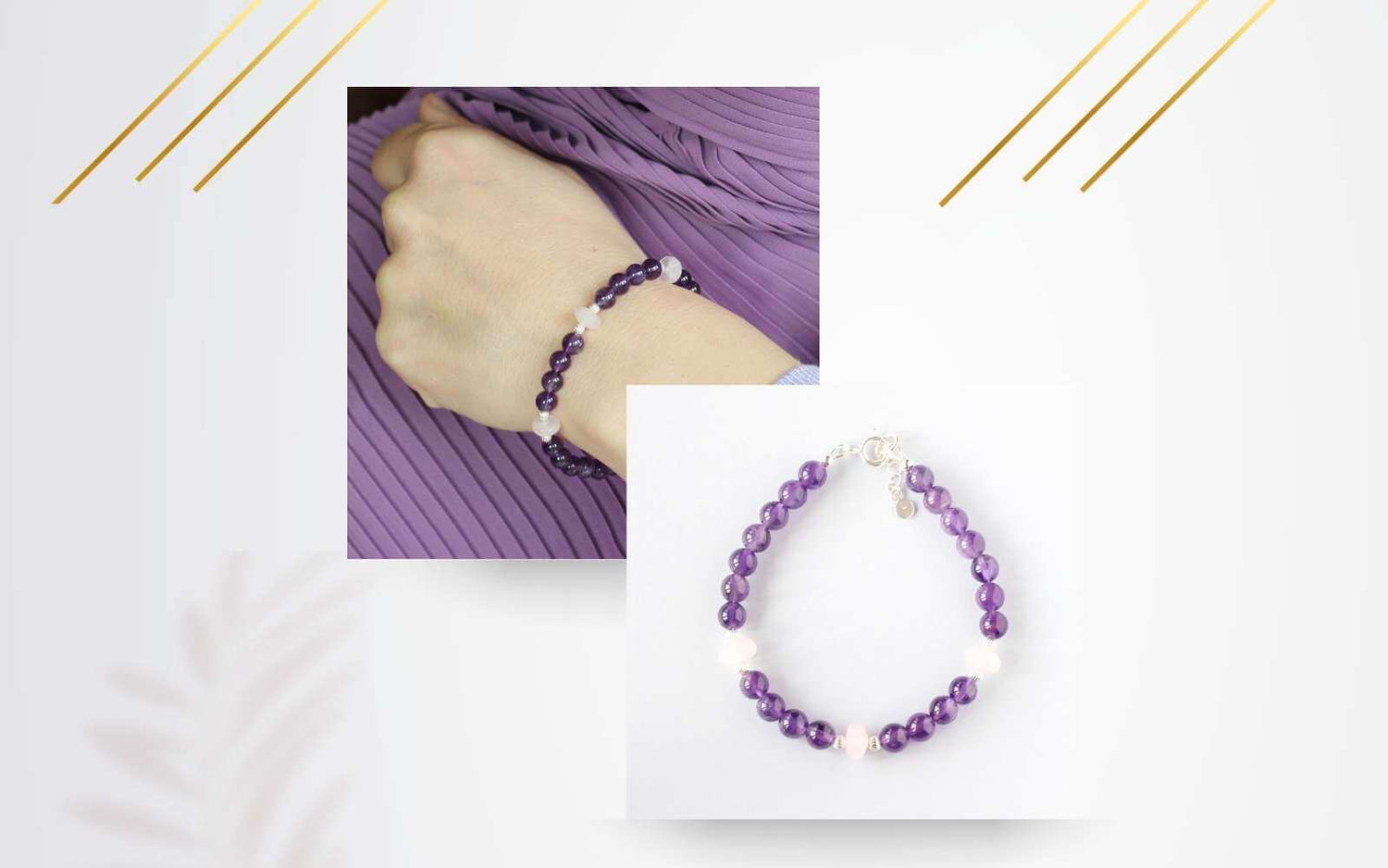
February Birthstone – The Most Popular Purple Gemstone
Amethyst February Birthstone
Amethyst is the February birthstone and the world’s most favoured purple gemstone. It is highly admired for its beauty and powers to soothe the mind and emotions. It is also the stone of St. Valentine and faithful love.
Colours of Amethyst
The February birthstone is a purple type of quartz mineral species. Amethyst is often found in geodes. These are globe-like rocks with crystals lining the inside wall. It occurs in primary hues from a light pink-violet to deep purple. Amethyst can be clear or opaque. Amethyst, often consists of pointed zones of darker to lighter colour. Its colour is largely due to traces of iron and other trace elements. Natural irradiation also impacts the aspect of Amethyst.
There are many types of Amethyst of which six are the most well-known. These include purple, ametrine, pink, mossy, cape and prasiolite Amethyst. It is known as Cape when layered with white quartz. Ametrine is Amethyst mixed with citrine. Mossy Amethyst has small veins seen through the beads. Prasiolite has a yellow-green look with hints of purple.
The value of Amethyst is based on colour rather than carat weight. The most costly Amethyst gemstones are dark purple with reddish tints.
Hardness and Deposits of Amethyst
Amethyst rates a 7 on the Mohs scale. It has good toughness which makes it suited for all types of jewellery. Mohs is a scale that measures how scratch-resistant minerals are. The scale measures from 1 to 10. One is the softest and ten is the hardest. Amethyst has a mixture of attractive colours and is also moderate in price. For that reason, it is no wonder that the February birthstone is so popular. It is widely used in beaded jewellery. You can also check our Amethyst designs in the photos in this blog post.
Amethyst is quite common and is found on all continents. The larger deposits are currently mined in South America, Africa and North America. The largest global producers are Brazil, Uruguay and Zambia.
History of February Birthstone
People have admired Amethyst for thousands of years. The gemstone has been included in royal collections from Ancient Egypt to the British Crown Jewels. In Ancient Egypt, this February gemstone was carved into the shapes of sacred creatures. Later, they were used as shielding amulets.
Ancient Greeks and Romans believed in its power to prevent drunkenness. Amethyst is mentioned in the Old Testament. It is one of the twelve stones of the tribes of Israel on the breastplate of the high priest Aaron (Exodus 39).
Early Christians linked Amethyst with Christ. This is because its purple colour evoked the wounds he suffered during the crucifixion.
In the Middle Ages, it became the choice stone for Clerics. Cardinals, likewise bishops and members of the Catholic church, wore this stone. Amethyst is the stone of St. Valentine and faithful lovers. St. Valentine is also thought to have worn an Amethyst ring engraved with Cupid's image.
The colour purple is a classic colour of monarchs. Amethyst has been used to adorn rich and powerful rulers. At that time it was costly and hard to produce. For some time, Amethyst was valued the same as diamonds. British royalty was very fond of it, so this February birthstone has been featured in many Coronation pieces. It was also known as a unique favourite of Catherine the Great.
Origin of Amethyst Name
This February birthstone got its name from the Greek word ametusthos, meaning “not intoxicated". Both Greeks and Romans highly regarded this gemstone. Ancient Greeks believed that Dionysus, the god of intoxication and celebration, created Amethyst.
As the myth goes, Dionysus, angered by an insult, vowed to punish mortals who refused to partake in his gifts, which were wine and intoxication. A maiden named Amethyst crossed his path and refused to partake. He became even angrier and summoned a pair of tigers to devour Amethyst. Artemis saw what was happening and to prevent the tigers from harming the maiden turned Amethyst into a crystal statue. Dionysus quickly realised his error and wept into his wine, which he then spilt onto the statue. Amethyst was transformed into a purple crystal, and since that day, the stone has been used as protection against intoxication.
Meaning of February Birthstone
Semi-precious stones and crystals have been an integral part of human history, representing wealth and power as well as being ascribed to physical and emotional healing properties.
Throughout history, the special virtue of Amethyst was to prevent drunkenness and overindulgence. In today’s world, Amethyst is a stone of spirituality known for many healing abilities. It is excellent for quietening the mind and is an aid to finding deep inner peace and discovering the wisdom residing in ourselves. It carries the energy of fire, passion, creativity and spirituality. Amethyst is one of the best crystals for meditation. To relax the system and increase awareness, hold a single Amethyst crystal or small clusters in the left hand during meditation to draw its energy into the body.
Benefits of February Birthstone
Gemstones are used in physical crystal healing as an alternative medical technique to protect and heal from disease. Amethyst’s energy decreases the pain of headaches and migraines and reduces stress and nervous tension. Referred to as “nature’s tranquiliser” the February birthstone calms, soothes and relieves obsessive-compulsive disorder and hyperactivity in children and animals. Place under the pillow to cure insomnia caused by an overactive mind. It is a stone dedicated to reducing overindulgence and addictive habits and is believed to help with quitting smoking, drinking and drug use.
How to Care for Amethyst Jewellery
Amethyst gemstone is a durable stone suitable for jewellery use. However, some care should be taken to maintain its colour and polish. Accidental scratches on hard objects or abrasions with harder gemstones can cause damage. It is best not to wear Amethyst jewellery in activities which could cause damage. These activities include doing house chores, gardening or physical activities like playing sports.
The February Birthstone has been known to fade in direct sunlight and care should be taken to avoid this. Sudden temperature changes can also break it over time. Anything too cold or too hot will cause damage.
It is best to keep your Amethyst jewellery, when not worn, in your jewellery box or a small plastic bag. This will help to protect them from damage, metal tarnish and sunlight. Amethyst can be cleaned with warm soapy water and a soft cloth or brush. Rinse your piece of jewellery and pat it dry. Caring for your Amethyst jewellery will keep it looking its best for many years to come.
How to Wear Amethyst Jewellery
The word "Amethyst" is now the name of a colour as well as the name of a gemstone. The purple colour combines the stability of blue and the energy of red. It is associated with royalty, wisdom, creativity and magic. It symbolises power, nobility, luxury and ambition.
Due to its vibrant and strong purple colour, Amethyst jewellery can very easily and elegantly make a statement for your outfit. Navy and pink are colours that complement Amethyst while yellow, orange and green are contrasting colours. This should be taken into consideration when choosing your outfit for any occasion and the desired impact you would like to achieve.
Discover what birthstones you can wear for other months in our "Birthstones by the Month" blog post.
References:
“Crystal Power, Crystal Healing” Michael Gienger






